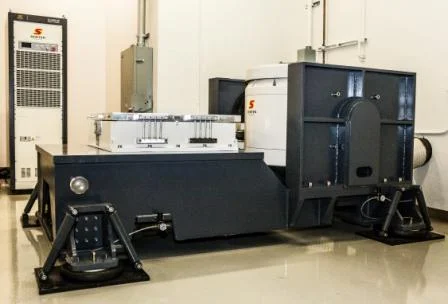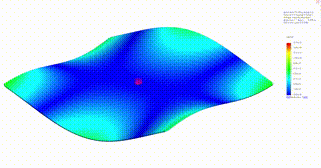Finite Element Analysis (FEA) frequency simulation allows the user to perform predictive analysis in the design phase and make alterations to the design if any major issues in the design are encountered in the simulation. However, it should be noted that real-world test data of the device should always be used to verify FEA results. A device’s resonant frequencies and mode shapes at those frequencies can be predicted using FEA. In this article, the resonant frequencies of a flat plate will be analyzed.
Figure 1. Flat Plate 3D model ready for FEA
Below are the results of the FEA used to predict the first 7 mode shapes of a 24” x 24” x 0.125” flat plate.
Figure 2. First Resonant Frequency @ 15.9 Hz
Figure 3. Second Natural Frequency 16.1 Hz
Figure 4. Third Natural Frequency @ 23.7 Hz
Figure 5. Fourth Natural Frequency @ 31.1 Hz
Figure 6. Fifth Natural Frequency @ 40.5 Hz
Figure 7. Sixth Natural Frequency @ 61.7 Hz
Figure 8. Seventh Natural Frequency @ 75.9 Hz
Figure 9. Animation of Seventh Natural Frequency Mode Shape Deflection
This analysis provides an initial understanding of where the first 6 resonant frequencies could occur as well as what the mode shapes could look like. If the results raise concerns about the product’s performance, changes to the design can be made before any prototype is constructed, reducing production time and cost.
If a fixture is being designed for use in a vibration test, it is important to design it in a 3D modeling software and perform FEA on the model to understand the resonant frequencies and mode shapes of the fixture and how they could affect the results of the vibration test.
This analysis was performed at Sentek Dynamics’ Charlotte, North Carolina test, demo, service, and assembly facility. Keep an eye on this webpage for a future video where this plate is tested on an electrodynamic shaker showing the resonant frequencies of the plate when tested on a shaker.
A continuously developing technological field calls for constantly innovating vibration testing systems. Sentek Dynamics is committed to providing powerful and efficient solutions for all your vibration testing needs.
For testing inquiries or to schedule a product demo day contact Sentek Dynamics at https://www.sentekdynamics.com/testing-evaluation-services.












